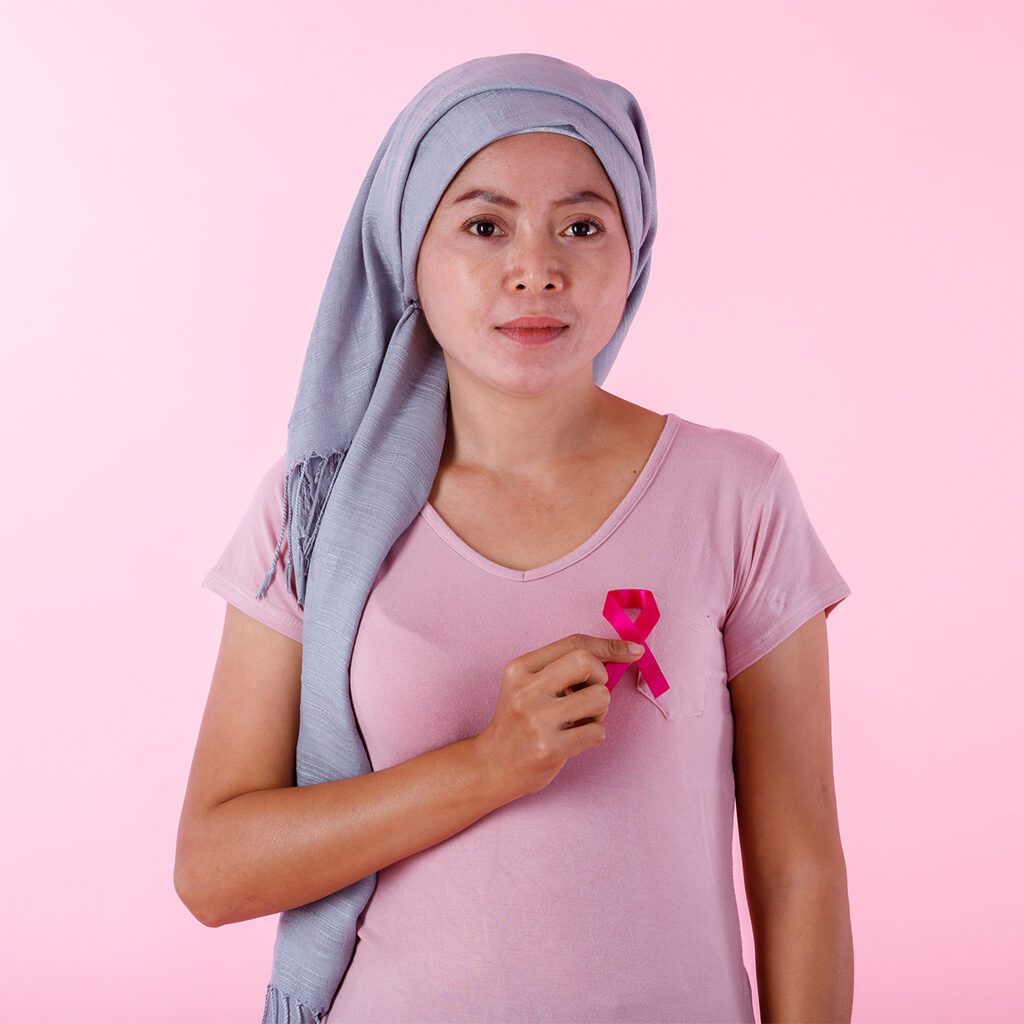Among the sea of vibrant autumnal shades you’ll see this season, you’ll also notice a slightly out-of-place hue: pink. It’s the official color for breast cancer awareness, often found in the form of a ribbon. From professional athletes and celebrities to those participating in local community and school events, virtually everyone dons the color to show support, promote awareness, and raise money for the most common type of cancer to affect women in America other than skin cancer.

Most breast cancers begin in the ducts (tubes that carry milk to the nipple) or the lobules (glands that produce milk) and can metastasize to other parts of the body.
Breast cancer accounts for an estimated 30% of all cancer diagnoses in American women. “On average, 1 in 8 women will develop breast cancer in her lifetime,” explains Dr. Betsy Washburn, medical director for the MaryEllen Locher Breast Center at CHI Memorial. In 2018, the American Cancer Society estimates just over 266,000 new cases of invasive breast cancer will be diagnosed, and nearly 41,000 women will die from the disease. In addition, there are more than 3.1 million American women with a history of breast cancer, including those currently undergoing treatment as well as survivors.
What Causes Breast Cancer?
Genes. We’ve all got ’em. Every cell in our bodies contains genes, which are what make us each so unique. Unfortunately, sometimes genes develop mutations, which can increase the risk of certain diseases, including breast cancer. “Mutations are alterations in a gene that cause it to malfunction or not function,” explains Dr. Laura Witherspoon, medical director for Erlanger’s Center for Breast Health.
Breast cancer is caused by one of two gene mutations: Acquired mutation or inherited mutation.
Over 85% of breast cancer cases are caused by acquired mutations, which means a woman’s cells have changed over the course of her lifetime due to age or other factors. This mutation is NOT genetic. “Acquired mutations only affect the person who has the mutation, and those mutations are not passed down to children,” Dr. Witherspoon explains. Researchers believe radiation exposure and contact with cancer-causing chemicals contribute to acquired gene mutations, but specific causes are mostly unknown.
While rarer, as much as 10% of all breast cancer cases are related to an inherited mutation. These mutations run in families and drastically increase the chances of developing breast cancer. The most common type of inherited mutation occurs in the tumor-suppressant BRCA (BReast CAncer) genes, which include BRCA1 and BRCA2. Dr. Washburn explains, “BRCA1 and BRCA2 are normal genes we all have, but in some people these genes are mutated, and this drastically increases the risk of certain cancers. These genes are designed to maintain cell growth, but when they don’t function properly, cells have the potential for unchecked growth – the definition of cancer.”
Even if you do have a BRCA1/2 mutation though, breast cancer isn’t necessarily guaranteed in your future. BRCA1 carriers have a 55-65% chance of developing breast cancer by age 70, and BRCA2 carriers have a 45% chance of developing breast cancer by age 70.
Risk Factors
In addition to genetic mutations, certain other factors can put a woman at increased risk for developing breast cancer. Age is one, as most breast cancers are diagnosed after age 50. Another is the density of your breasts; lots of connective tissue can make it difficult to identify tumors. Family history of the disease is a red flag, as is a personal history of the disease – if you’ve had it once, you are more likely to develop it again. An unhealthy lifestyle, which can manifest in the way of being overweight, not exercising, drinking too much, or smoking, increases your risk too. And lastly, the length of exposure to hormones can affect your chances; women who start their periods before age 12 or start menopause after age 55 are at an increased risk, since they are exposed to hormones for longer periods of time.
“There are several reasons why a woman should consider genetic testing,” says Dr. Washburn. Her red flags include:
- Two first-degree relatives (mom, daughter, sister) that have had breast cancer
- One first-degree relative that was diagnosed with breast cancer younger than age 50
- Three or more second-degree relatives diagnosed with breast cancer at any age
- Any male breast cancer in the family
- Any first or second-degree relative with breast and ovarian cancer
- Ashkenazi Jewish Heritage


Taking Precautions and Early Detection
“There is no absolute prevention against breast cancer; however, there are risk factors associated with development of breast cancer that can be managed,” shares Dr. Witherspoon. These include:
Knowing your risk level.
The first step in taking precautions against breast cancer is knowing your risk level. Be aware of your family’s health history and relay that information to your physician. It may be helpful to speak with your parents, siblings, and grandparents for the most accurate history.
Getting screened.
Beyond maintaining regular checkups with your gynecologist, getting screened is the key to early detection of breast cancer. Mammograms can detect any changes or developments early, when it’s most treatable. Women ages 40 to 44 should discuss with their doctor when to begin mammograms. Women ages 45 to 55 should get mammograms each year, while women 55 and older can opt to have the screening performed every two years.
Performing breast self-exams.
Approximately 40% of diagnosed breast cancers are detected by women who feel an abnormal lump. Women of all ages should perform self-exams on a monthly basis. By knowing what your breasts normally look and feel like, you’re able to notice if something changes or feels weird.
Knowing the symptoms.
Other abnormal changes to your breast may include swelling, skin irritation or dimpling, breast or nipple pain, nipple retraction, redness or thickening of the nipple or breast skin, or nipple discharge.
Making healthy lifestyle choices.
It’s the usual suspects – don’t smoke; maintain a healthy weight by eating a well-balanced diet high in vegetables and lean proteins while exercising for at least 30 minutes, five days a week; and limit your alcohol intake. Research suggests that the more you drink, the greater your risk of developing breast cancer.
Breastfeeding your children, if you’re able.
Studies have shown that breastfeeding might play a role in lowering your risk for breast cancer. The longer you breastfeed, the greater the preventative effect is for your body, with the best effects noted in women who breastfeed for one year or longer.
How to Perform a Breast Self-Exam


While in the shower, in front of the mirror, or lying down, perform a self-exam by moving the pads of your fingers around your breast in a circular motion, taking care to check the entire breast and armpit. Also, squeeze your nipple to check for discharge and lumps. If you’re concerned by a new change, such as a mass or lump in the breast, call your doctor immediately.
Treatment Options
If you or someone you know is diagnosed with breast cancer, there are numerous highly individualized treatment options. Depending on the type, stage, and characteristics of the cancer, treatment options can range from local (meaning you can treat the tumor without affecting the rest of the body) to systemic (which reaches cells throughout the entire body and is generally used for cancers that have spread).
The most common methods of treatment are: a lumpectomy or partial mastectomy (surgery to remove the cancer), sometimes followed with radiation therapy; a mastectomy (surgery to remove the breast); or chemotherapy, radiation, or hormone therapy.
While receiving a breast cancer diagnosis can be life-changing and scary, remember that recovery rates are high, especially when caught early. Keep up with regular doctor visits, and never hesitate to get checked if you recognize any signs that feel “off.” You know your body better than anyone, so be confident in your convictions.


Dr. Betsy Washburn
Surgeon and Medical Director, MaryEllen Locher Breast Center at CHI Memorial


Dr. Laura Witherspoon
Surgeon and Medical Director, Erlanger Center for Breast Health

